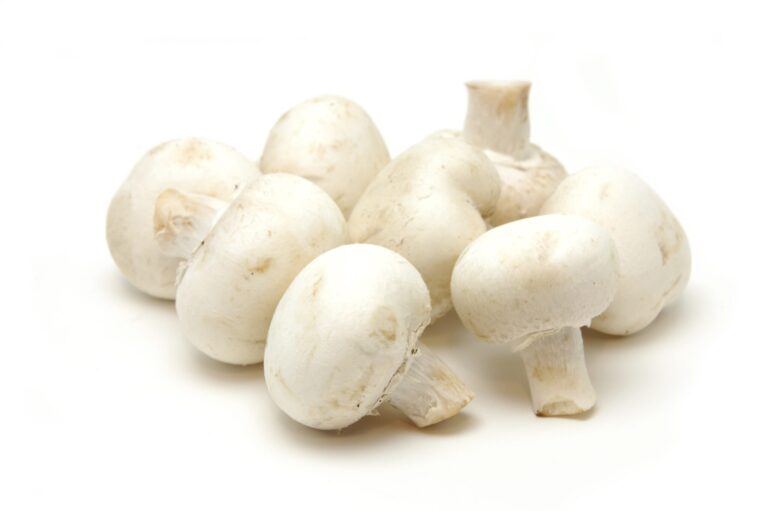The Versatility and Delight of Button Mushrooms
Button mushrooms, scientifically named Agaricus bisporus, are a versatile and popular ingredient in the culinary world. Their mild flavor and delicate texture make them a staple in dishes worldwide. In this article, we will explore the culinary uses, nutritional benefits, and provide delicious recipes featuring button mushrooms to inspire your culinary adventures.

Understanding Button Mushrooms
Button mushrooms belong to the Agaricus genus and are one of the most commonly cultivated mushroom varieties globally. These small, round mushrooms feature a smooth white cap and a short stem. They are harvested during the early stage of growth, which is why they are often referred to as “buttons.”
The cultivation process of button mushrooms involves carefully controlled conditions, including temperature, humidity, and nutrient levels. This meticulous approach ensures consistent quality and availability throughout the year, making button mushrooms a readily accessible ingredient for culinary enthusiasts.
Culinary Uses and Flavor Profile
Button mushrooms offer a mild and slightly earthy flavor, which intensifies when cooked. Their subtle taste makes them incredibly versatile, allowing them to complement a wide range of dishes. Whether sautéed, grilled, roasted, or used in soups, stews, or stir-fries, these mushrooms add depth and texture to any culinary creation.
Sautéed Button Mushrooms: A Classic Delight
One popular method of preparing button mushrooms is sautéing them to perfection. To achieve this, start by heating a skillet over medium-high heat and adding a knob of butter or a drizzle of oil. Once the fat has melted and is sizzling, toss in the mushrooms and let them cook until they turn golden brown and develop a rich aroma. Season them with salt, pepper, and a pinch of herbs like thyme or rosemary for an added burst of flavor. Sautéed button mushrooms make a delectable side dish or a delightful addition to pasta dishes, omelets, or salads.
Other Culinary Applications
Button mushrooms are incredibly versatile and can be used in various culinary creations. Here are some ideas to inspire your next culinary adventure:
Stuffed Mushrooms: Hollow out the mushroom caps, fill them with a savory mixture of breadcrumbs, herbs, cheese, and other ingredients of your choice. Bake until golden brown and enjoy these delightful bite-sized treats.
Mushroom Risotto: Add sautéed button mushrooms to a creamy risotto for a flavorful and satisfying dish. The mushrooms’ earthy notes blend beautifully with the rich creaminess of the rice.
Mushroom Gravy: Enhance your dishes with a flavorful mushroom gravy made by simmering button mushrooms with onions, garlic, broth, and a touch of cream. This versatile sauce pairs wonderfully with roasted meats, mashed potatoes, or vegetables.
Incorporating Button Mushrooms into a Healthy Lifestyle
Whether you follow a specific dietary regimen or simply strive to maintain a healthy lifestyle, button mushrooms can be a valuable addition to your meals. Here are some ways you can incorporate them into your diet:
1. Mushroom-Based Meat Substitutes
Button mushrooms have a unique texture that, when cooked, can resemble certain meat varieties. This characteristic makes them an excellent option for individuals seeking plant-based or vegetarian alternatives. Finely chopped or minced button mushrooms can be used in recipes that traditionally call for ground meat, such as burgers, meatballs, or taco fillings. The mushrooms add depth of flavor and a satisfying texture while reducing the overall calorie and fat content of the dish.
2. Mushroom-Based Soups and Broths
Button mushrooms are a fantastic ingredient for creating rich and flavorful soups and broths. Their umami qualities lend depth and complexity to the overall taste profile. You can enhance the nutritional value of your soup by incorporating a variety of vegetables, herbs, and spices alongside button mushrooms. Whether it’s a classic mushroom soup or a hearty vegetable broth, these creations will warm your soul and nourish your body.
3. Mushroom and Grain Bowls
For a wholesome and satisfying meal, consider preparing mushroom and grain bowls. Start with a base of cooked grains such as quinoa, brown rice, or farro. Top it with sautéed button mushrooms, roasted vegetables, leafy greens, and a protein source of your choice, such as grilled tofu or chickpeas. Drizzle with a flavorful dressing or sauce, and you have a nutrient-packed and delicious bowl that can be enjoyed for lunch or dinner.
4. Mushroom-Based Pasta Sauces
Upgrade your pasta dishes by incorporating button mushrooms into the sauce. Sauté them with onions, garlic, and your preferred herbs and spices. Add tomato sauce or cream, depending on your taste preferences, and let the flavors meld together. Toss the sauce with your favorite pasta and garnish with fresh herbs and grated cheese for a delightful and satisfying meal.

Nutritional Benefits of Button Mushrooms
Beyond their culinary appeal, button mushrooms also offer several nutritional benefits. They are low in calories, making them an excellent choice for those aiming to maintain a balanced diet. Additionally, they are a valuable source of essential nutrients, including:
Vitamins and Minerals: Button mushrooms contain a range of vitamins and minerals, including B vitamins (such as riboflavin, niacin, and pantothenic acid), copper, potassium, and selenium.
Dietary Fiber: These mushrooms are a good source of dietary fiber, which supports healthy digestion and can contribute to a feeling of fullness.
Antioxidants: Button mushrooms contain antioxidants, such as ergothioneine and selenium, which help protect the body’s cells from damage caused by harmful free radicals.
Nutritional Profile of Button Mushrooms
Beyond their culinary applications, button mushrooms offer a range of essential nutrients that can contribute to a well-rounded diet. Here is a closer look at the nutritional profile of these remarkable fungi:
1. Low in Calories and Fat
Button mushrooms are incredibly low in calories, with approximately 20 calories per 100 grams. They are also low in fat, making them an ideal ingredient for those watching their calorie intake or following a weight management plan.
2. Rich in Vitamins and Minerals
Button mushrooms contain various vitamins and minerals that are beneficial for overall health. Some key nutrients found in these mushrooms include:
B Vitamins: Button mushrooms are a good source of B vitamins, including riboflavin (vitamin B2), niacin (vitamin B3), and pantothenic acid (vitamin B5). These vitamins play essential roles in energy production, maintaining healthy skin, and supporting brain function.
Copper: Button mushrooms are a natural source of copper, a mineral that aids in the production of red blood cells and supports the proper functioning of the immune system.
Potassium: These mushrooms are a decent source of potassium, an essential mineral that helps regulate blood pressure, balance fluids in the body, and support proper muscle and nerve function.
Selenium: Button mushrooms contain selenium, an antioxidant mineral that helps protect the body against oxidative stress and supports a healthy immune system.
3. Good Source of Dietary Fiber
Button mushrooms are a valuable source of dietary fiber, which is important for maintaining a healthy digestive system and promoting feelings of satiety. A serving of button mushrooms can contribute to your daily fiber intake, aiding in digestion and supporting overall gut health.
4. Antioxidant Properties
Button mushrooms contain antioxidants, such as ergothioneine and selenium, which help protect the body’s cells from damage caused by harmful free radicals. These antioxidants play a role in reducing oxidative stress and inflammation in the body, potentially offering various health benefits.
Choosing and Storing Button Mushrooms
To fully enjoy the flavor and nutritional benefits of button mushrooms, it is essential to select and store them correctly. Here are some tips to keep in mind:
1. Selection
When purchasing button mushrooms, look for firm caps with a smooth texture. Avoid mushrooms that have bruises, blemishes, or appear slimy. The stems should be intact and free from any signs of deterioration.
2. Storage
To extend the shelf life of button mushrooms, store them properly. Remove the mushrooms from any packaging and transfer them to a paper bag or a loosely covered container. Place them in the refrigerator, where they can stay fresh for up to a week. Avoid storing them in plastic bags, as they can retain moisture and lead to spoilage.
3. Cleaning
Before using button mushrooms, gently wipe them with a damp cloth or paper towel to remove any dirt or debris. Avoid washing them under running water, as mushrooms are porous and can absorb excess moisture, resulting in a less desirable texture when cooked.
In Summary
Button mushrooms are a versatile and delicious ingredient that can elevate the flavors of various dishes. From sautés and soups to pasta sauces and grain bowls, these mushrooms offer a mild and earthy taste that complements a wide range of culinary creations. Additionally, they provide several nutritional benefits, including vitamins, minerals, dietary fiber, and antioxidants.
By incorporating button mushrooms into your meals, you can add depth of flavor, texture, and essential nutrients to support a healthy lifestyle. So, embrace the wonders of button mushrooms and explore the endless possibilities they offer in the kitchen.
Remember, when seeking the freshest and finest button mushrooms for your recipes, trust in reputable suppliers who prioritize quality and freshness. With these culinary delights at your disposal, your culinary creations will undoubtedly impress and delight your taste buds.